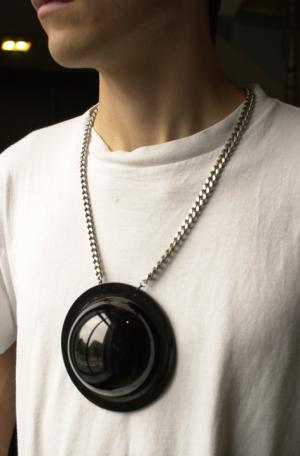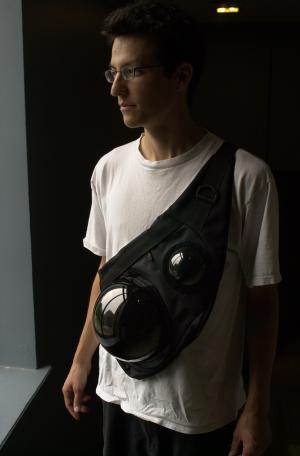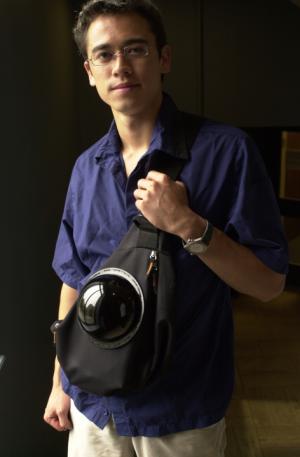Technomimesis and Sousveillance: Using Technology to Challenge Technosocial Surveillance.
| Steve Mann | Jason Nolan | Barry Wellman |
| Electrical and Computing Engineering | Knowledge Media Design
Institute | Sociology |
| University of Toronto | University of Toronto |
University of Toronto |
Correspondence author: S. Mann = mann@eecg.toronto.edu
University of Toronto
10 King's College Road, Room S.F. B540
Tel. (416) 946-3387; Fax: (416) 971-2326
Abstract
Mann's demonstrations of how reflectionism and
sousveillance can be used in device design and to generate
"sousveillance", and his using of devices in a deliberately
obfuscatory manner not only shines a bright light on the issue of surveillance, but explores mechanisms to challenge social norms, as a way of opening dialogues. The issue is not about how much surveillance and sousveillance is present in a situation, but generating an awareness of the disempowering nature of surveillance, its overwhelming presence in western societies, and the complacency of all participants towards this presence.
Introduction
The intention of this paper is to resituate the work of Professor
Steve Mann, cyborg, inventor, engineer, social critic and artist in
the context of sociological discourse. Mann's work challenges much of
academia due to its interdisciplinary nature, experimental design,
confrontational positioning and performativity. The nature of his design work and inquiry puts him in conflict with many requirements for academic research such as the ethics of informed consent, explicit methodologies and research agendas; requirements that lead most academics to work in labs, controlled spaces, and existing
literature. His background in engineering, computers, and performance art as both forms of expression and tools for social inquiry have allowed him to driectly engage the social issues surrounding surveillance as part of an emergent research design agenda situated in ethnomethodology and action research (Carr and Kemmis, 1986; Masters, 1995).
Our paper takes up the work of Mann as an example of action
research that directly confronts technosocial surveillance using the
technologies of oppression as technologies of emancipation,
challenging the unstated assumptions of surveillance, ownership of
space, and the assumptions of implicit urban interactional
contexts. In order to do this we must look at Mann's idea of
reflectionism, an interplay of techno-mimesis and tech-nemesis has
been applied to the design of a variety of data collection devices
based on wearable computers, as part of Mann's eyetap project
(http://www.eyetap.org). We then describe how Mann uses his tools to engage in a dialogue with surveillance, to question the social hierarchy surveillance
re-enforces. For Mann, issues of social hierarchy and privacy are explored
through transgression of technological norms that mirror the
technological framework of department stores,
gambling casinos, post offices, etc., where surveillance is the primary source of governance and control. The dialogue is initiated by members of Mann's group who enter these locations and start collecting the same kinds of data tthat is collected through existing surveillance techniques wearing what Mann calls reflectionist devices.
His primary goal is to engage in a dialogue with customer service personel, managers, security workers while wearing these reflectionist devices, in situations where the
devices gave rise to a breaking of usually unstated rules within the
establishments.
A typical example of Mann's method is the collection of video or photographic records within a
department store. Such activity is expressly prohibited by the
customer service personel under ordinary circumstances, is permitted by the same personel
to continue collecting records if the wearer claims to be unable to stop, for various reasons such as external authority or inability. This has led Mann to suggest that such devices can be used to explore issues of self-empowerment through this type of
design.
What is Reflectionism: Situating Ethnomethodological and action research inquiry
Reflectionism incorporates a series of ideas that center around the idea of challenging technology-based surveillance as a form of governance. The notion of
techno-mimesis and the role of a tech-nemesis as method,
location of inquiry, and rationale for the counter-surveillance (sousveillance) situate Mann's work within the Action Research tradition (Carr and Kemmis, 1986; Mann, 1998). The mimetic act of
holding a mirror to the social environment is something that Mann moves beyond written narrative to the actual use of similar surveillance techniques to "watch the watchers", and this ability allows for the potential taking up of the nemetic role of "bringer of social justice" presented as an act of inquiry. Techno-mimesis is a term coined to contain
idea of holding a critical lens (using the tools of surveillance to
'watch the watchers') up to accepted social situations through the use of technology. It partakes of both action
research where
research inquiry is used to bring about social
change, and ethnomethodology which inquires into a social reality that
"is an intersubjectively shared and socially constructed
phenomenon". The
positioning of Mann's research as antagonistic and directly critical of
techno-social surveillance partakes of this desire to enact social
change through research inquiry the emergent social phenomenon of
technosocial surveillence.
Ethnomethodological and action research inquiry into social
phenomena situate Mann's Reflectionism as a position that engages, challenges and
inverts the power structure of networked surveillance. The role
reversal between the surveilled individual and the act of surveillance,
explores the social interactions that are generated by reflectionist
observation, and suggest a series of scenarios and questions which
Mann hopes to conduct further inquiry; primarily issues of collective-
and self-empowerment within the panopticon of social surveillence and
the governance of public and semi-public places (Foucault 1977; Ostrom, 1990).
Mann's ethnomethodological inquiry leads to
the exploration of techniques for repositioning the dialogue on
surveillance within a public discourse by empowering the researcher,
as a member of the public, to bring the technologies of surveillance
to bear on the social hierarchy and those whose profession it is to
maintain the a hierarchy of surveillance.
Reflectionism challenges the taken for granted notions of ubiquity,
location, physical place and cyberspace, by taking them up in the
context of transgression, privacy, and technology (Newman, 2000). Contemporary
western society has tried to make technology mundane and somewhat
invisible through its disappearance into the fabric of our buildings,
consumed objects and lives. Through the creation of "pervasive
computing", "ubiquitous computing", "smart
floors", smart toilets, smart elevators, smart light switches,
intelligent environments, intelligence gathering devices,
"ubiquitous surveillance", etc., digital technologies are
replacing the mechanical technologies of previous generations. And they are becoming equally invisible. But
with this re-placement of technologies, and the concomitant data
conduits, comes new opportunities for observation, data collection and
surveillance.
Jeremy Bentham's panopticon defined an observation
system in which people could be placed under the possibility of
surveillance without knowing whether or not they were actually under
surveillance:
the major effect of the Panopticon [was] to induce in the inmate as state of conscious and permanent visibility that assures the automatic functioning of power. So to arrange things that the surveillance is permanent in its effects, even if it is discontinuous in its actual action; that this architectural apparatus should be a machine for creating and sustaining a power relation independent of the person who exercises it; in short, that the inmates should be caught up in a power situation of which they are themselves the bearers. (Foucault,1977, 201)
This possibility of surveillance
was intended to put the surveilled to be on their best behaviour at all times.
Bentham proposed such an architecture for use in prisons, schools,
hospitals, and workplaces.(Foucault,1977, 205)
Ostrom's notions of self-governance
also reflects the traditional importance of observation as a primary force
of social cohesion in self-governed communities; that it is the ability to both observe and know what eachother is doing that is central to the maintenence of common spaces. (Ostrom, 1990, 59) But what is new can be found by further inquiry into the embeddedness of
surveillance technologies, and the unequal access to these
technologies, by the general public. The tools of the watcher are now very different than the tools generally available to the watched.
The Panopticon is designed such that the knowledge that there may
be surveillance is sufficient to induce obedience to authority (Foucault, 1977). One way to challenge and problematize both the obedience and surveillance is to take the same panoptic elements and
re-situate them on the individual to watch those in the tower. We coin
this inverse-Panopticon as being "sousveillance" from the
French for "sous" (below) and "veiller" (to watch). (Mirriam-Webster, 2002) Just like individuals watching guards from below the tower, seeks a device design allowing individuals (customers
photograph shopkeepers; cab passengers photograph cab drivers;
citizens photograph police officers; civilians photograph government
officers) the ability to adopt sousveillance to counteract
establishment surveillance. In many cases, this violates prohibitions on non-employees using recording devices. Following the methodology of
Garfinkel who gained insight into unspoken social rules by being
deliberately deficient in social co-operation and refusing to
"play the game", Mann's mirroring of establishment surveillance and
thus breaking known policies, forces an examination of the interaction
outcomes and behavioural effects on customer service personel (Garfinkel, 1967; Mann, 2000; Mann 2001). This work is unique in
that Mann is not designing for a particular user, but he is designing for a
particular situation; the violation of rules. Due to the clandestine nature
of his research, it makes sense to have the device on the body of the
surveilled (customer, taxicab passenger, consumer, etc.) in the form of wearable computing devices.
Researchers such as Spears and Lea (1994) have discussed the ability of computer-mediated communication to equalize or
reinforce power relations. And in
certain social contexts, it has been suggested that Foucault's
metaphor can be extended to computer-mediated communication as a form
of increased social control by reinforcing established bureaucratic
relations. In fact, Foucault states just this: "Panoptism was a technological invention in the order of power, comparable with the steam engine." (Foucault, 1980b, 71) In contrast,by reducing observeability, as well as cues to status and power, individuals are less
likely to be influenced by them resulting divergence from group
conformity and obedience to powerful others. We have not yet identified any research into face-to-face computer-mediated communication (communication involving computers where individuals are co-located in a single physical space) designed purposely to challenge or problematise the power relationship initiated by observation.
Solutions offered to privacy concerns have mainly dealt with
technology enhancements, such as developing rules and protocols to
negotiate privacy between personal agents and the environment. (Rhodes et al., 1999) Personal empowerment in wearable computing has also focused on
enhancement via software features to augment one's knowledge
base. However, access to more information does not imply greater
self-power as this information could be controlled or exchanged via an
external agent. Personal empowerment, though, can also be viewed in a
social context on its human-human interaction effects. It is this social form of self-empowerment which Mann seeks to examine through the design of the
devices to force a dialogue between the customer and customer service personel regarding surveillance policies in commercial establishments.
Reflectionism in Ethnomethodology Design
Instead of designing devices and interfaces for the user as
consumer of a product, Mann designs for situations where the focus is the dialogue that develops between the wearer of the
various device(s) and individual in public and commercial venues. Ethnomethodological inquiry embraces the level of uncertainty that surrounds these dialogues. No one is ever sure of the outcome of the interaction between device, wearer and conversant. Mann work with the understanding that design
factors can influence sociological factors of
interaction. (Dryer, et al., 1999) For example, it has been
suggested that people who have more familiar mobile devices
(such as laptop computers and personal digital assistants) are perceived to be
more socially desirable than those with less familiar devices. (Dryer, et al., 1999)
The wearing of technology can be seen as either acceptably empowering or unacceptably threatening, depending on the type of technology and location. The opportunity for engaging in sociological discourse about the role of technology and surveillance in our society changes based on numerous factors as
well. A central goal, however, is to understand how an individual who
is wearing sousveillance devices is perceived,
as well as how attitudes toward surveillance and sousveillance
are reinforced or challenged.
A naive interpretation of Reflectionism might leave one to think
it is nothing more than bothering low-level customer service personel
and engaging only the lowest level personnel who are merely
symptomatic of a systematic problem, not the progenitors.
However, with Reflectionism, Mann does directly challenge individuals who work for commercial concerns:
- Often, the customer service worker is, either "just following
orders" from management, or acting in whit is felt to be in the best interest of management.
This scenario can continue up a hierarchy where management claims the surveillance cameras
were installed by a directive from head office. Head office can say that
the insurance companies require the cameras. It becomes impossible
to isolate and identify a specific responsible entity.
Perhaps a manager of a department store would even pretended to be a customer service worker, in a indicate that
"you must have permission from the manager to take pictures here"
hoping not to be revealed as that person in a position of responsibility.
-
Reflectionism rapidly escalates the engagement and the
associated discourse to the highest available level of
authority. With Reflectionism the
manager comes running out to see what is going on, and becomes
personally engaged in the dialog. The director of security suddenly
becomes available for immediate discussion. This is research in action, confronting agents directly and attempting to engage them in dialogue that is otherwise difficult to initiate.
To Mann, Reflectionism tries to engage the customer service worker to reflect on his/her practice in concert with the reseracher (See "Can humans being customer service personel make customer service personel be human?" http://wearcam.org/itti/).
In Mann's case, the mimetic/nemetic persuasion comes as a result of
computer-mediated communication. The difference between his work and
the captology framework (Fogg, 1997) is that he is not persuading users of his
tools of inquiry (e.g. wearers of the devices) directly. Instead, are
attempting to persuade people who interact with users of the devices
within the context of a normal daily activity (e.g. when users of his
devices shop or pretend to shop at a department store). The dimension
of behaviour under examination trying to open a dialogue with workers
with the goal of helping them to see that they are part of an oppressive social
hierarchy.
If customers complain about establishment's surveillance system,
such as the mysterious ceiling domes, Mann's group suggests that the
customer service personel either claim not to know what is in the domes or the customer service personel
absolve themselves of responsibility by redirecting us to speak with
"the manager". (Mann, 2001) The manager can be bound by or can
pretend to be bound by policies from a CEO, who is bound by a board of
directors, and so on. The bureaucracy creates a
credible and unquestionable authority allowing customer service personel to pretend to (or actually) have no control over. Customer service personel
therefore externalize and absolve themselves of responsibility,
a responsibility to a social order they complicitly help to
maintain. Using reflectionist design to mirror establishments'
surveillance, we have created a situation of inverse-Panopticon
surveillance (what we call "sousveillance").
Examples of Interactions and Locations of Inquiry
Mann and his team have conducted experiments over a 22 year time
period in various countries around the world, under a wide variety of
circumstances. Because multiple observers were often present
inconspicuously, to document the event, he maintains that the reliability of noting
important details and description of the observations and
circumstances was high. The observations further supplemented the
experiences of many years of usage with similar devices, in less
formal acts of inquiry.
Mann inverts Stanley Milgram's camera experiments where people
facilitate the taking of photographs (Milgram, 1977) by examining the degree to
which customer service personel will try to suppress photography in location where it is
forbidden. Unlike many establishments' use of surveillance, Mann
often deliberately makes it clear to customer service personel that their image is being
taken. This is accomplished by providing appropriate image feedback
on either a flat-panel screen or a data projector. The pictures were taken
with either a pinhole camera, a flash-camera or a camera concealed
under a dome. Mann suggests that the probability of interaction
decreases with a decrease in device overtness (Mann, 2001). By having a
salient display, debate is instantaneously provoked without the need
for any comments from the wearer of the devices who are initially
secondary in the interaction.
Observations
The intended purpose of these kinds of wearable computing devices
is to provoke a response from individuals the researchers confront
during their experiments.
Making the camera very obvious
In this situation, two cameras used with the high intensity
wearable projection computer system, including: the concealed infrared
night vision camera of Performance Two, and an additional ordinary
hand held camera mounted to headgear. The purpose of using the
additional camera was to make the act of taking a picture very
obvious. Firstly, the additional camera chosen (a Kodak DC 260) looks
very much like a camera, so that its function is very obvious. Also,
unlike the infrared night vision camera it has a loud simulated click
sound, that calls attention to itself whenever it takes a
picture. Moreover, it has a built in electronic flash, so that even if
customer service personel are facing in the opposite direction, they are quickly alerted
to the fact that a picture has been taken. The device corresponds to
consumer conceptions of what a camera should look like. When they turn
to see what caused the flash, they can see their picture projected on
the ground. To make the image capture more obvious, both pictures
(still freeze-frame, as well as live video from the infrared imaging
system) are displayed side-by side. The flash serves as a very
effective annunciator, to
indicate clearly that a picture is being taken every 19 seconds (the
update rate of the color still camera). The text "CAMERAS REDUCE
CRIME..." is used in the projection, together with the still and
video displays. The observations begin in a series of shops,
restaurants, malls, department stores, and the like, and ends on a
street as with past performances. In many establishments, objections
are raised to the taking of pictures for reasons that tend to centre
around establishment policy.
If the wearer does not appear to be under control of the apparatus,
that customer service personel often permit the wearer to continue to remain in the shop
in some iterations of the experiment. Measures are taken to ensure
that the wearer appears to have no control over the apparatus:
- The wearable computer system is completely hands-free. The
wearer has no controls, no keyers, no mice, no buttons to push, and no
other form of control over the apparatus.
- The apparatus is
automated, or controlled externally, so that it continues to take
pictures while the wearer is explaining to the customer service worker that it is beyond
his control.
- The apparatus is designed so that it has the
appearance of being non-removable by the wearer. The wearer appears
unable to remove the apparatus. For example, the wearer can explain to
the customer service worker that the device is held on by security screws for security
purposes.
- The situation is created so that the wearer could
show that he is required, by a manager, to wear the device, as part of
the performance art piece (e.g. a contract, as a performance artist,
or the like).
Mann notes found that shopkeepers, customer service personel, and other officials would
often permit or accept the fact that the wearer is taking pictures in
their establishments, when the wearer could attribute these acts to
external (e.g. non-voluntary) circumstances or control, at one of the various steps along the externality continuum describe earlier.
As well, the wearer can claim to be subject to various obligations
to not remove the device:
- The wearer refuses to stop taking
pictures -- personal volition.
- The wearer is
bound by contractual obligation to take pictures as part of a
performance piece. The wearer's livelihood depends on doing this. This
is how the wearer makes his living -- contractual
obligation.
- The wearer simply is unable to remove or
stop the device from taking pictures -- ignorance or
inability.
Other variations on similar themes, include deliberate prior
adjustment of the camera so that it would malfunction and get stuck in
the "on" position. When such malfunction is explained to the
customer service personel, they often accept the photography in their
establishments.
It was found that the greater the appearance of personal control,
the less acceptable the act of image gathering. For example, the level
of tolerance and acceptability for taking pictures varies according to
the degree of the externality continuum. At the extreme, if the wearer
explains the fact that he is not in control of the device and does
not know when it takes a picture, then the majority of customer service personel
do not object to a wearable data-collection computer system.
And while initial objections to photography are often quickly made, after
diffusing the control and responsibility of the device to an external
authority, the customer service personel often make no further comments.
In other situations, if the wearer appeared to be "just following orders" mirroring the usual response patterns Mann observed in customer service personel,
the act of taking pictures was tolerated. For example, a wearable camera
made very obvious by flashlamp and a loud click for each picture, as well
as by display of image content, was found to produce an extreme
negative reaction. But the negative reaction could be countered by
using a headset with microphone, and talking to a remote "boss"
and explaining loudly, "They seem to be objecting to having their
pictures taken...."
Compliance, or apparent compliance,
to a credible external authority, seems to reduce
objections made by customer service personel.
Ideally, to be most effective, the wearer needs to be "oppressed"
in the same way that the customer service worker is "oppressed".
Thus, for example, the wearer of the eyeglasses is required, by an external
manager, to wear the eyeglasses, while running errands on company time.
Thus if the wearer of the computerized eyeglasses is simply wearing a uniform
while purchasing some items for his company's business, and the eyeglasses
are part of the uniform, there is greatly incresed acceptance of the
wearer's requirement to wear the uniform.
In some versions of the eyeglasses, a "comfort band" was designed to go
around the back of the wearer's head so that the wearer could not remove
the glasses.
In this way, the wearer and the department store customer service worker can feel sorry for
each other's state of "oppression" while their respective managers require
them to photograph each other.
Meanwhile, while they engage in what would normally be a hostile act of
photographing each other, they can be quite collegially human to one another,
and discuss the weather, the baseball game that was on TV last night, or
how terrible their respective managers are treating them by forcing them
to photograph each other.
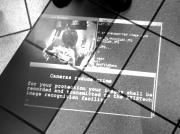
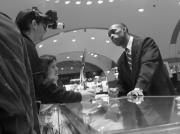
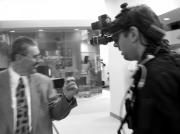
(a) Projected text: "Cameras
reduce crime; for your protection your image shall be recorded and
transmitted to the EXISTech.com image recognition facility. (b)
Confrontation with top officials at an upscale jewelry store. (c) A
favorable reaction was obtained from department store security staff
who thought the device was a good invention.
Conspicuously concealed cameras with wearable
flat panel displays
Whereas performance three targeted primarily at upscale jewellery
stores, gambling casinos, and other establishments being similar in
nature to those in which the investigators had been required to leave,
the goal of this set of performances is to create an ambiguous
situation in which data-gathering wearable computer systems are
conspicuously concealed. For example, "blatantly covert"
domes are used. (See Fig. domewear.)
This figure shows a line of products, along with a corporate brochure
that was created to present the artifacts in the context of purchased
goods. As a result, a department store security guard objecting to the wearing
of such apparatus would also, by implication, be objecting to a
legitimate product of the legitimate consumerist society that his or her
store was trying to uphold. Some performances involves re-situating surveillance domes onto
wearable computers. Some of the experimental apparatus also
incorporates various large flat panel data display screens, worn on
the body, displaying video from a concealed camera, or even from a
previous trip to the same shop (e.g. "no camera", so that
when told that photography was prohibited, the wearer could indicate
that no camera was present and that he was merely playing video
recorded previously from the same shop).
In one situation, the investigators offer to cover up the data
display with a piece of paper so that it would no longer bother the
customer service personel. (See Fig. paperscreen.)
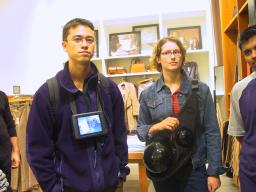
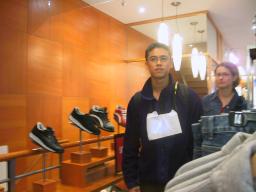
These images relate to a particular experience where individuals
(presumably undercover security guards) object to the mere display
of images captured within their retail establishment. The wearable
computer with wearable 640x480 video display device is found to be
most disturbing when it plays images of merchandise similar to that
which come from a camera in this establishment, regardless
of whether or not a camera was actually present. When persons
claiming to be staff of the establishment objected to the video
displays, the investigators offered to cover up the displays with
sheets of paper. This offer to cover up the wearable display devices,
so that the images would no longer be visible, are presented as a
means of isolating the issues of privacy (the right to be free of the
effects of measuring instruments such as cameras) from the issues of
solitude (the right to be free of the effects of output devices such
as video displays).
This situation created a distinction between the often conflated
issues of privacy (as is violated by input devices such as cameras)
versus solitude (which is violated by output devices such as video
displays). The wearable computers with domes are found to create a
very interesting dialog, because the size of the dome could be varied,
e.g. a number of wearers having progressively larger and larger domes
would enter an establishment until a complaint was raised. Answers
would need to be provided to the customer service personel. In some cases, the
investigators played back video recordings of the same customer service personel, or of
other customer service personel in other shops. The video recordings had been generated
by entering the shops with hidden cameras and asking the customer service personel what
their domes on the ceilings of their shops were. For example, the
investigators had a recording of department store customer service personel
telling that the domes on their ceiling were temperature sensors. A
record store owner had told the investigators that their dark ceiling
domes were light fixtures. By playing back these recordings with flat
panel displays, for the customer service personel to see, a true form of reversalism took
place. It was found that the same kind of surveillance domes used by
establishments could be reflected in wearable computing. These
hemispheres of wine-dark opacity which may or may not contain
surveillance cameras, and are so commonly found on the ceilings of
many shopping establishments and gambling casinos, now give way to a
true reflectionist model. The fact that the domes may or may not
contain cameras creates an important design element for the wearer,
because it is possible to arrange the situation such that the wearer
does not know whether or not the apparatus contains a camera. Thus
when questioned about the wearable domes, the investigators could
reply with uncertainty.
Another element of the performance is a mockery of visibility and
transparency. In one performance, a back-worn wearable flat panel
display was arranged to show a view from a front-worn camera. When
asked what this apparatus is, the wearer says that it is an
"invisibility suit". This notion is nonsense, in the sense that the device
certainly does not give invisibility (in fact it attracts all the more
attention). However, it was found that by presenting the camera as art
(e.g. as in Magritte's 1936 painting of a painting showing reality,
as described in http://wearcam.org/easel.htm),
unusual actions are accepted.
Presenting the camera as part of a form of theatre, in the context of
a humourously nonsensical invisibility suit performance,
somehow legitimizes it, as an externality.
A similar result was found when the investigators described the
domes as "lucky charms to chase away evil spirits". Such a
nonsensical attribution to a clearly external force or notion or
nonsense, was found to greatly increase the acceptability of wearing
computers in establishments where cameras are normally strictly
forbidden.
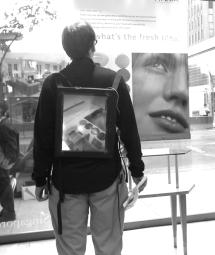
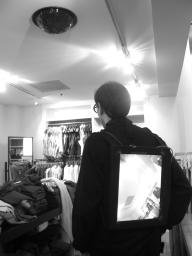
Conspicuously displayed cameras are worn in establishments where
cameras are prohibited. A large 1024x768 flat panel display has
been incorporated into one of the wearable computer systems. To
maximize screen size on the body, the screen was mounted
sideways. The second image shows Sousveillance under surveillance: standing under one of
the department store's ceiling domes. The third image shows a backworn display shows
output from a frontworn camera, so that people can see right through
the wearer. The wearer's back has a window, showing what is in
front of the wearer. And when asked what the device is, the
wearer responds with a nonsensical answer, namely that the apparatus is
an invisibility suit to provide privacy and protection from
surveillance cameras. Such a silly answer externalizes the locus of
control of the wearable camera, first such a crazy idea as an
invisibility suit makes it hard for the customer service worker to reason with the
wearer. Second, this is obviously performance art, fashion, and
theatre of the absurd, the technology being a necessary part of the
performance piece. Third, the wearer can argue that the motivation
for wearing the camera is to protect the wearer from being seen by the
department store's camera. The wearer can even claim that his manager
requires him to wear the invisibility suit. The customer service worker's objection
to the wearer's manager's sousveillance camera is transformed into an objection to
the customer service worker's manager's surveillance camera.
Conclusion
The performative nature of Mann's work, over the past two decades,
has meant that he conducts inquiry into the unstable research
environment of public spaces such as streets, sidewalks, malls and
shopping malls. And most recently this has included airports
(http://www.nytimes.com/2002/03/14/technology/circuits/14MANN.html). Mann's form of 'gorilla inquiry' is action research that
takes up his subject through direct engagement, and what could be
termed as civil disobedience, or at the very least,
disruption of the norms and even unacknowledged acts
of oppression by which commercial establishements, corporations,
security organizations and their agents (sometimes unwittingly) participate .
The authors of this paper, therefore,
have collectively chosen to focus attention on the design,
conceptualization and performance/inquiry of Mann and his students,
rather than trying to do a detailed analysis of the actual data collected using
unsuspecting or unwilling participants. It is our goal to replicate or simulate aspects of Mann's work as a follow up project under more traditional research conditions.
REFERENCES
Carr, W. and S. Kemmis (1986). Becoming Critical: Education, Knowledge and Action Research. London, The Falmer Press.
Coyne, R. (1999). Technoromanticism: digital narrative, holism, and the romance of the real. Cambridge Mass., MIT Press.
Dryer, D.C., Eisbach, C., Ark, W.S. "At what cost pervasive? A social computing view of mobile systems." IBM Systems Journal 38, 4 (1999), 652-676
Fogg, BJ. Captology: "The Study of Computers as Persuasive Technologies", in Extended Abstracts of CHI '97 (Atlanta GA, March 1997), ACM Press, 129.
Fogg, BJ. "Persuasive Computers - Perspectives and Research Directions", in Proceedings of CHI '98 (Los Angeles CA, April 1998), ACM Press, 225-232
Foucault, M. (Sheridan, A. trans) Discipline and Punish Vintage Press, New York, 1977.
Foucault, M. (1980a). "Prison Talk." Power/Knowledge: Selected Interviews and Other Writings 1972-1977. C. Gordon. New York, Pantheon: 37-54.
Foucault, M. (1980b). "Question of Geography." Power/Knowledge: Selected Interviews and Other Writings 1972-1977. C. Gordon. New York, Pantheon: 61-77.
Garfinkel, H. Studies in Ethnomethodology . Polity Press, Cambridge UK, 1967.
Gaver, W. and Dunne, A. Projected Realities - Conceptual Design for Cultural Effect, in Proceedings of CHI '99 (Pittsburgh PA, May 1999), ACM Press, 600-607.
Graves, Robert. (1955) "Nemesis". The Greek Myths: 1. Harmonsworth: Penguin.
Ingham, R. Privacy and Psychology, textit{Privacy}, John Wiley & Sons, 1978, 35-57
Masters, J. (1995) 'The History of Action Research' in I. Hughes (ed) Action Research Electronic Reader, The University of Sydney, on-line http://www.behs.cchs.usyd.edu.au/arow/Reader/rmasters.htm (download date 00.00.0000)
Mann, S. Can Humans Being customer service personel make customer service personel be Human? - Exploring the Fundamental Difference between UbiComp and WearComp. Informationstechnik and Technische Informatik 42, 2 (2001), 97-106.
Mann, S. "Computer Architectures for Protection of Personal Informatic Property: Putting Pirates, Pigs, and Rapists in Perspective." First Monday 5,7 (July 2000), http://www.firstmonday.dk/issues/issue5_7/mann/
Mann, S. "Reflectionism" and "Diffusionism": New Tactics for Deconstructing the Video Surveillance Superhighway. Leonardo 31, 2 (1998), 93-102.
Milgram, S. The Individual in a Social World. Addison-Wesley Publishing Co., London UK, 1977.
Newman, Judith M. (2000, January). Action research: A brief overview [14 paragraphs]. Forum Qualitative Sozialforschung / Forum: Qualitative Social Research [On-line Journal], 1(1). Available at: http://qualitative-research.net/fqs.
Ostrom, E. (1990). Governing the Commons: The Evolution of Institutions for Collective Action. Cambridge, Cambridge University Press.
Ostwald, M. (2000). "Virtual Urban Futures". The Cybercultures Reader. D. Bell and B. M. Kennedy. London, Routledge.
Pentland, A. and Choudhury, T. "Face Recognition for Smart Environments" Computer 33, 2 (2000), 50-55
Rhodes, Bradley J., Nelson, Minar and Weaver, Josh. "Wearable Computing Meets Ubiquitous Computing: Reaping the best of both worlds", in Proceedings of The Third International Symposium on Wearable Computers (San Francisco CA, October 1999), 141-149.
Rogers, Ted W. in Gupta, Sunil (ed) Disrupted Borders: An Intervention in Definitions of Boundaries, Rivers Oram Press, London UK, 1993
Spears, R. and Lea, M. "Panacea or Panopticon? The Hidden Power in Computer- Mediated Communication" Communication Research 21,4 (1994), 427-459
Ward, T. "The Situationists Reconsidered:, in Kahn, D. and Neumaier, D. (eds.), Cultures in Contention, The Real Comet Press, Seattle WA, 1985.
